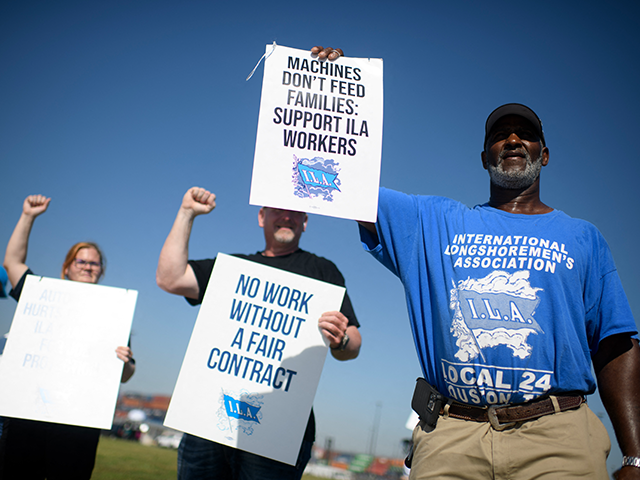How Biden-Harris Inflation Sank the Longshoremen
The longshoremen strike that began Tuesday is at its heart a labor protest against the disastrous inflation brought on by the reckless Biden-Harris economic policies.
The International Longshoremen’s Association has asked for a $5 an hour increase in each year of the six-year deal, which would raise the upper limit of hourly pay from $39 an hour to $69 an hour. While that amounts to a 77 percent increase over the term of the contract, it really should be understood as making up for lost real wages during the recent wave of inflation.
When the union last negotiated its contract in 2018, it won for dockworkers a $1 per hour increase per year on wages that started at $20 for new workers and reached a maximum of $39 per hour. At the time, inflation had mostly run below the two percent target of the Federal Reserve for a decade, and it was running even lower that summer. The Federal Reserve’s projections had inflation running at 2.1 percent over the next few years. So, the union thought they would be getting the equivalent of two to three percent real wage gain each year.
Inflation upended that. The maximum of $39 is now worth $30.70 in 2018 dollars, and the starting wage is the equivalent of $15.75. Real wages, in other words, have declined dramatically as the cost of living increased.
What the longshoremen are asking for is compensation for past inflation and some additional insurance against future inflation. Under the terms asked for by the union, workers will not even be back to where they thought they would be in real terms until sometime in 2026. In other words, the union’s demand was so mild that it would not even make the workers whole until the second year of the contract.
Longshoreman union leader Harold Daggett said Tuesday morning that the Biden administration had suggested a $4 an hour increase per year as a compromise position. Daggett has signaled that his union might have accepted that offer, which would have meant an even slower climb out of the hole dug by inflation.
The negotiators for the management group representing ship lines, terminal operators and ports, however, came back with an offer of $3 an hour per year. At that rate of increase, it is possible that the longshoremen would never recover their spending power. So, management was proposing that the longshoremen would never recover from the Biden-Harris inflation explosion.
The Coase Theorem Comes to U.S. Ports
The union workers have also demanded protections against automation or semi-automation. This has led some to conclude that the union is digging in its heels against technological progress. But, as anyone familiar with labor history will tell you, this is really just a negotiation tactic. What the union is doing here is not fighting automation in principle but rather seeking compensation for the inevitable loss of work and wages that automation will bring.
To understand this, it’s helpful to frame the debate in the terms laid out by Ronald Coase in his landmark paper, “The Problem of Social Cost.” The Coase Theorem, as we now know it, holds that when property rights are clearly defined and the costs of negotiation are low, private parties will bargain their way to an efficient outcome. The logic is simple: It doesn’t matter who holds the rights—what matters is that both sides have incentives to negotiate toward a deal that leaves everyone better off.
So, let’s apply this to the standoff over automation. If the efficiency gains from automating the ports are as significant as management claims, there should be no trouble coming to an agreement. The longshoremen, recognizing that their jobs are on the line, would have every incentive to accept some form of compensation in return for allowing the ports to modernize. In an ideal Coasean world, this would result in the smooth adoption of new technology with the workers getting paid for their trouble and the port operators realizing greater productivity and profit.
But here’s where the rubber meets the road—or perhaps where the hull meets the berth: If management is balking at offering the workers adequate compensation for their losses, we might reasonably question whether the promised gains from automation are all they’re cracked up to be. After all, if the net benefits of automation were truly as large as advertised, the cost of buying off the union would be a drop in the bucket. The fact that negotiations have stalled suggests that the efficiency gains from automation, at least in this instance, may not justify the costs—unless, of course, the real goal isn’t efficiency but simply to reduce labor costs by pushing out higher-wage union jobs.
The Coase Theorem isn’t just an abstract economic principle; it’s a useful lens through which to view real-world conflicts like this one. In theory, there’s always a price that could be paid to get everyone on board with automation. If that price isn’t being paid, it might be because the true benefits of automation aren’t as compelling as we’ve been led to believe.
The longshoremen, in other words, want their wages to be great again after years of suffering from high inflation. And they want a share of the upside from automation.

COMMENTS
Please let us know if you're having issues with commenting.